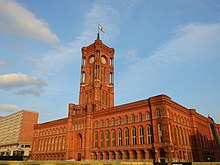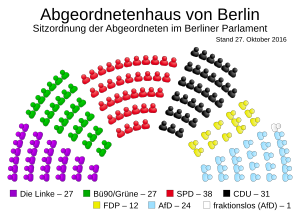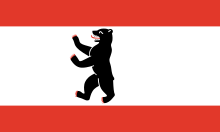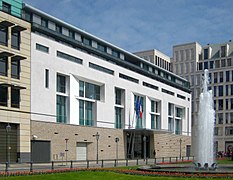Politics in Berlin
The policy in Berlin is divided into federal, state and district policy.
Due to the status of Berlin as a city- state, state politics extends to the interests of the city as a whole. The district policy is implemented by twelve individual districts at the local level.
Berlin is also the capital of the Federal Republic of Germany. From there, federal policy is shaped by the various constitutional organs.
State of Berlin
Constitution
The Constitution of Berlin (VvB) is the state constitution of the German state of Berlin and came into force on November 23, 1995. It replaced the constitution of September 1, 1950.
State politics

The state and the city of Berlin are governed by the Senate of Berlin ( executive ), which includes the governing mayor and the senators . The governing mayor corresponds to the minister-presidents of other federal states at state level ; there is no separate mayor for the city . The Senate meets in the Berlin City Hall (Rotes Rathaus). He is supported in his work by the Senate Chancellery .
The legislature is represented by the House of Representatives, which meets in the Prussian state parliament . Due to a reform of the state constitution in 2006, the conditions for instruments of direct democracy in Berlin were strengthened, which has since led to several popular legislative procedures .
The senate administrations correspond to the ministries in large states and are constituted as follows in 2018: Senate administration for finance , Senate administration for integration, labor and social affairs , Senate administration for education, youth and family , Senate administration for health, care and equality , Senate administration for interior affairs and sport , Senate Department for Justice, Consumer Protection and Anti-Discrimination , Senate Department for Urban Development and Housing , Senate Department for Economy, Energy and Enterprises , Senate Department for Culture and Europe , and the Senate Department for Environment, Transport and Climate Protection .
Court organization
The judicial power ( judiciary ) is exercised in Berlin by the constitutional court of the state of Berlin and numerous other courts of the state.
Country cooperation
The state of Berlin works together on an institutional level with the neighboring state of Brandenburg. In 1992 the working group Police Cooperation Berlin / Brandenburg was set up. The joint state planning department Berlin-Brandenburg started its work in 1996 as the highest joint state planning authority . Some state institutions have a joint Berlin-Brandenburg line. In 2006 the RBB and the Deutsche Rentenversicherung Berlin-Brandenburg were founded. The higher administrative courts of both countries were merged to form the Berlin-Brandenburg Higher Administrative Court and the state statistical offices to form the Berlin-Brandenburg Statistics Office .
District politics
Since January 1, 2001, Berlin has been divided into the following twelve districts : Mitte , Friedrichshain-Kreuzberg , Pankow , Charlottenburg-Wilmersdorf , Spandau , Steglitz-Zehlendorf , Tempelhof-Schöneberg , Neukölln , Treptow-Köpenick , Marzahn-Hellersdorf , Lichtenberg , Reinickendorf .
Political bodies at the district level are the district assembly and the district office , which consists of election officials and is headed by the district mayor. When the district administration law was reformed in 2006, the option of petitioning and referendums was introduced for the first time at district level in Berlin.
The districts are politically represented in the council of mayors . In addition, the Tempelhof-Schöneberg, Marzahn-Hellersdorf, Mitte, Reinickendorf and Spandau districts are members of the Resource Control Working Group.
As parts of the state of Berlin, the districts bear their names without the prefix “Berlin-”. This linguistic usage is also extended to state institutions that are named after the districts: Terms such as the Tiergarten district court or the Charlottenburg tax office (each without "Berlin-") are used nationwide.
elections

|

|

|

|

|

|

|
|

|

|
||

|

|

|

|
Sovereignty symbols
The Berlin coat of arms shows in a silver (white) shield a red-armored and red-tongued, upright black bear , the so-called Berlin bear . A golden five-leaf crown of leaves rests on the shield, the headband of which is laid out as masonry with a closed gate in the middle. The origin of the bear as a heraldic animal is unclear, there is no document or documents on this. There are several theories why city officials chose the bear. One of them says that the Berliners thought of Albrecht the Bear , the founder of the Mark Brandenburg . Another is based on the onomatopoeic interpretation of the city's name. The bear is first seen on a seal from 1280. For several centuries, the bear had to share the seal and coat of arms images with the Brandenburg and Prussian eagles . It was not until the 20th century that the Berlin bear was finally able to assert itself against the eagles as the city's emblem.
The Berlin state flag shows the Berlin bear against a white background, with a red stripe at the top and bottom of the flag. It has been run by Berlin since 1911, with minor stylistic changes, and blew over the Rotes Rathaus for the first time in 1913. Before that, Berlin ran a flag in the colors black-red-white, which was exchanged for the bear flag due to constant confusion with the flag of the German Empire that was later created. The national symbol is the bear shield without a foliage crown in three colors. It is provided by the Senate Department for the Interior and Sports to enable private individuals, companies and non-sovereign institutions to document their ties to Berlin with a symbol. The Berlin districts have their own coats of arms. As a connecting element of all Berlin districts with the city of Berlin, but also with each other, rests on the shields a three-tower wall crown, the central tower of which is covered with the Berlin coat of arms (silver).
Federal capital
Federal politics
Since the reunification of the Federal Republic of Germany with the German Democratic Republic on October 3, 1990, Berlin has been the capital of the now common Federal Republic. On June 20, 1991, the German Bundestag decided in the so-called capital city resolution that Berlin should also become the seat of government and parliament of unified Germany.
Berlin is the seat of the first official residence of the Federal President in Bellevue Palace , the Federal Government , the Bundestag and the Bundesrat . In contrast to other capitals, Berlin is not the only seat of ministries and important federal institutions. Numerous federal authorities are still in the federal city of Bonn .
The Federal Chancellery is located in the Mitte district , as is the Reichstag building , where the Bundestag meets, and the former Prussian mansion , the seat of the Bundesrat.
Federal Ministries
Eight of the fourteen federal ministries in the 18th German Federal Cabinet have their headquarters in Berlin. These include the Foreign Office and the Federal Ministries of Finance ; for families, seniors, women and youth ; for work and social affairs ; of the interior ; of Justice and Consumer Protection ; for business and energy ; for traffic and digital infrastructure .
The other six federal ministries have their headquarters in the federal city of Bonn . All ministries, including those in the capital, have a second seat in the other city.
The federal ministries for education and research are in Berlin ; for food and agriculture ; for health ; for the environment, nature conservation, construction and reactor safety ; the defense and for Economic Cooperation and Development represented with a second seat. Around two thirds of the ministry employees, around 12,600 civil servants and collective bargaining employees (as of 2018), work in Berlin.
household
Federal expenditure (excluding special financing transactions) amounted to EUR 325.4 billion in the 2017 budget year. Compared to the actual result in 2016, expenditure in 2017 increased by 14.8 billion euros or 4.8%.
Income (excluding coins in circulation and excluding special financing transactions) amounted to 330.4 billion euros in 2017. The federal government received 8.4 billion euros or 2.6% more than budgeted.
Embassies and national representations
158 countries had their embassy headquarters in Berlin in 2017. As a result, Berlin, along with Brussels , Washington , Beijing , London , Paris and Tokyo, was one of the capitals with the highest number of established diplomatic missions. A large number of embassies are based in the Tiergartenviertel .
The 16 German federal states are represented in Berlin with state representations. You take on the role of mediator between federal and state politics. Therefore u. a. maintaining close relationships with the German Bundestag and the federal government in their field of activity.
Non-governmental organizations
One of the international non-governmental organizations based in Berlin is Transparency International e. Founded in 1993 in the city . V. (TI) . TI is a non-profit operates and has the global fight against corruption as well as the prevention of offenses associated with corruption in connection to the destination.
See also
Web links
Individual evidence
- ^ Website of the Senate Chancellery - accessed on April 13, 2019
- ↑ Senate Department for Finance , accessed on August 25, 2017.
- ↑ Senate Department for Integration, Labor and Social Affairs , accessed on August 25, 2017.
- ↑ Senate Department for Education, Youth and Family , accessed on August 25, 2017.
- ↑ Senate Department for Health, Nursing and Equal Opportunities , accessed on August 25, 2017.
- ↑ Senate Department for Home Affairs and Sport , accessed on August 25, 2017.
- ↑ Senate Department for Justice, Consumer Protection and Anti-Discrimination , accessed on August 25, 2017.
- ↑ Senate Department for Urban Development and Housing , accessed on August 25, 2017.
- ↑ Senate Department for Economics, Energy and Public Enterprises , accessed on August 25, 2017.
- ↑ Senate Department for Culture and Europe , accessed on August 25, 2017.
- ↑ Senate Department for the Environment, Transport and Climate Protection , accessed on August 25, 2017.
- ^ Council of Mayors - accessed April 13, 2019
- ↑ Resource Management Group - accessed on April 13, 2019
- ↑ Search for the responsible tax office. In: berlin.de.
- ↑ Overview of the German local courts. In: handelsregister-online.net, accessed on August 26, 2017.
- ↑ Are all ministries moving to Berlin after all? In: Die Welt , October 6, 2015, accessed on July 28, 2018.
- ↑ Bonn quota drops below a third. In: General-Anzeiger , January 12, 2018, accessed on July 28, 2018.
- ↑ Preliminary conclusion of the 2017 federal budget, Federal Ministry of Finance, accessed on August 1, 2018.
- ^ Transparency International Charter. Transparency International e. V. November 14, 2006; accessed on August 1, 2018.












